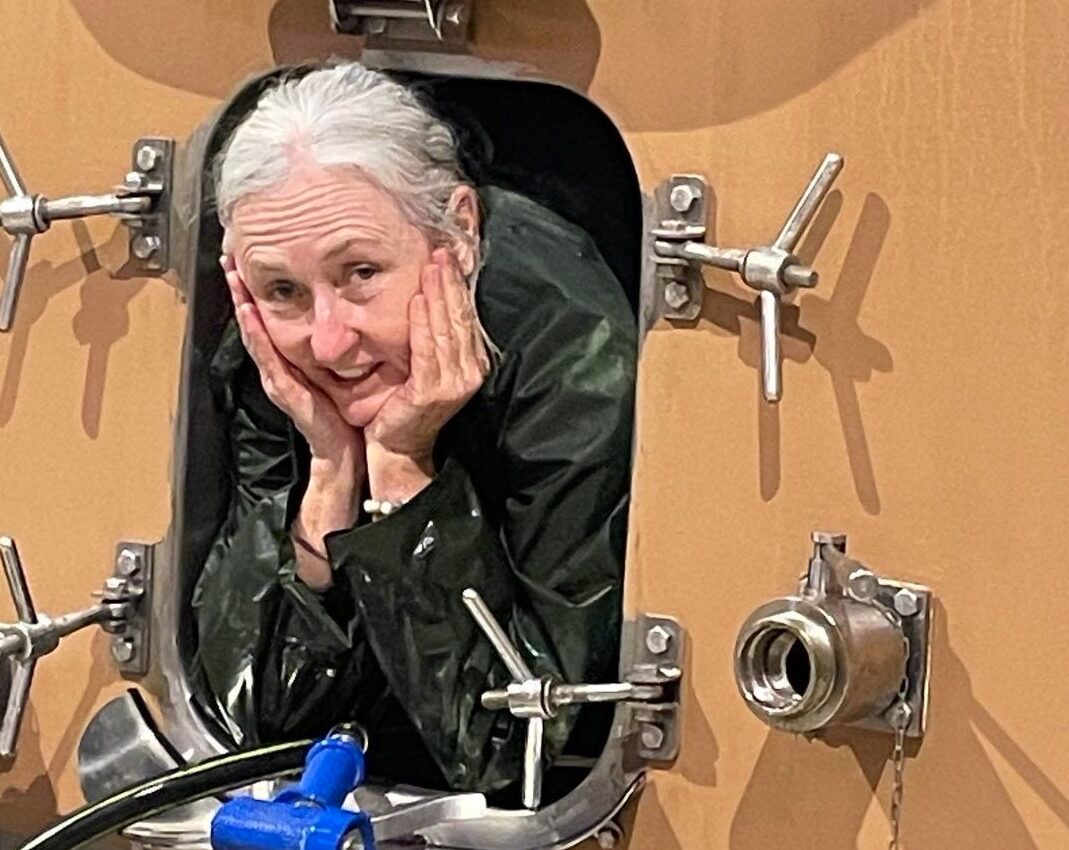After discussing winemaking trends with Estribeau and Turner, Lisse Garnett analyses 15 new wines from Domaine Uma and Les Vignobles Foncalieu – many of which she describes the value of as “insane.”

Tasting Foncalieu wines with Nathalie Estribeau, Carcassonne, July 14, 2023
We were a small, informal, heat-dishevelled, press party, at one of the most influential wineries in France. A Master Sommelier led our sweaty tasting (mid-heatwave) and his lengthy resumé by way of introduction was unexpected. His unassuming translator dutifully delivered each of his many personal accolades with poise and warmth, diplomatically trimming words where possible. Though she (and he) neglected to mention it, our humble translator was, in fact, our star. Modest, yet highly accomplished, winemaker Nathalie Estribeau who is the wine director of Les Vignobles Foncalieu, one of the most successful co-ops in France.
At Domaine Uma, we met winemaker Karen Turner, originally from Australia; her astonishing resumé surpasses many a famed publicised great; Brown Brothers, Hugel, Thelema, Taylor Fonseca, Chapoutier, Tenuta di Arceno, Rosemount, Prieuré St Jean de Bébian and Turner Pageot. Yet, she, too, chooses life under the radar, shunning socials and focusing only on wine (though I did spot her in French Elle). Chapoutier put Turner in charge of one of his wineries before she could even parlez Français. Incidentally, she had a successful career as a medical scientist before studying oenology in Adelaide.
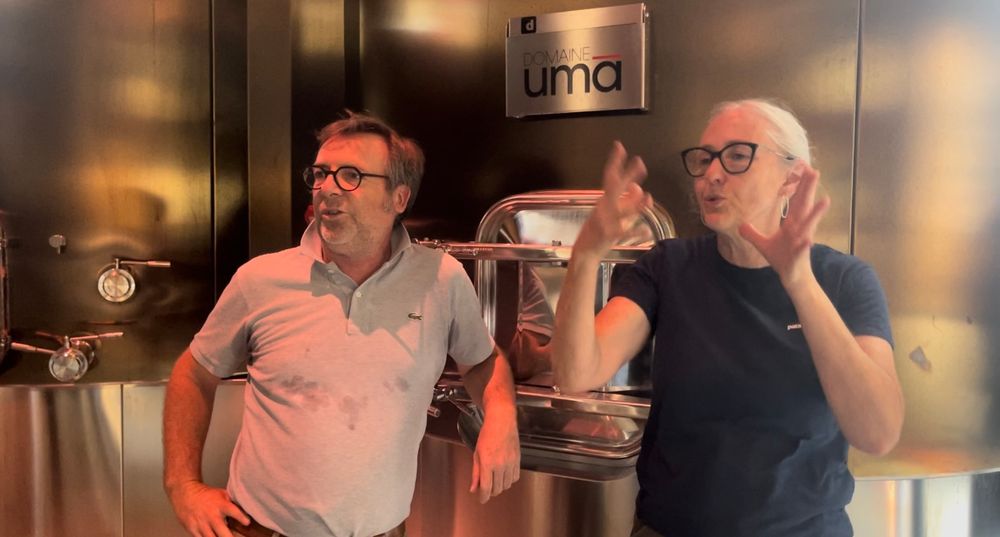
New winery Domaine Uma with owner Emmanuel Clausel and Karen Turner
Today, she heads up Domaine Uma, an exciting newly-minted venture in Pic Saint Loup owned by former property developer Emmanuel Clausel. Uma consists of 120 ancestral hectares, the merged former estates of Château Cambon and Domain de Valcyre and an added block of agricultural land. Wine tourism is the long-term goal, with a 5-star hotel, spa, bistro, wine school and gallery planned. The new winery has just been completed and is insane. I wanted to move in, but mild-mannered Clausel seemed unwilling to gift me the keys.
Nathalie Estribeau and ‘the new France’
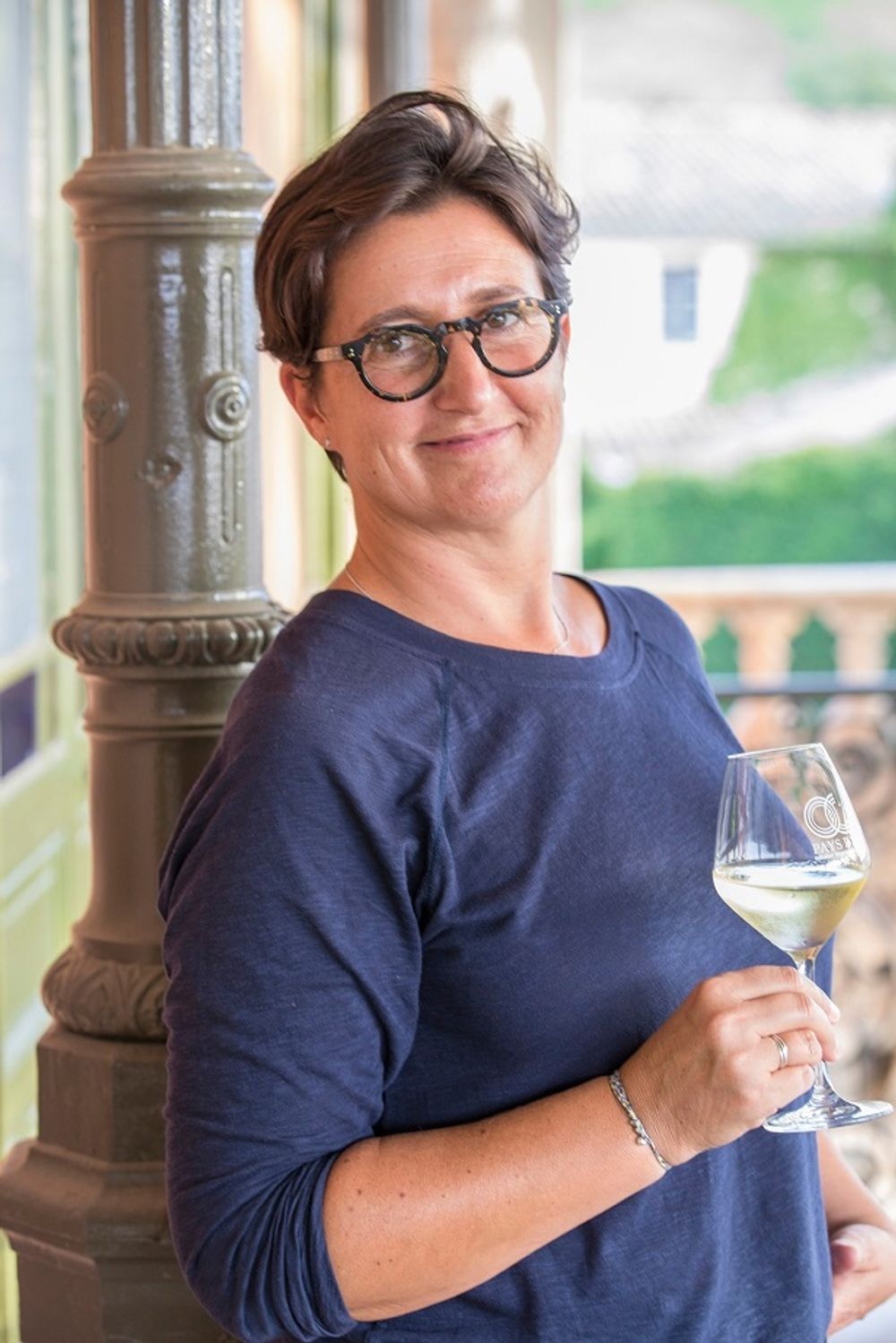
“In France, some wineries didn’t even unlock their doors,” Nathalie Estribeau
Nathalie Estribeau was born in Bordeaux, and her grandfathers had vineyards in Entre-Deux-Mers, though her parents did not. She had little interest in wine in her youth, and her family was not in the trade. Nevertheless, she studied oenology. She’s worked all over the Northern and Southern Hemispheres. Her seminal moment came when she met a natural winemaker in France who hooked her up with Pipers Brook in Tasmania; from there, she went to South Africa, Chile and Argentina. She became a consultant for Penfolds in the 90s, flying to Australia yearly before coming to rest in Carcassonne. She said Australians at that time were looking for fruit-driven wines,
“French wine was harder to approach than it is today because you didn’t get the fruit first; you got the tannins, the complexity; you wouldn’t get fruity wines, especially not from Bordeaux. It was also more secretive; Australia was far more open. In France, some wineries didn’t even unlock their doors, whereas, at Penfolds, they flung them open and explained absolutely everything; there were simply no secrets.”
“Today in the South of France and with younger generations, we share more things and are open to new ideas. Foncalieu has always been proactive in experimental vineyards and PIWI trials. (PIWIS are crosses between European vines and fungus/frost resistant American species, they allow for a huge reduction in pesticide use). We have 5000 hectares to play with and are always experimenting. We were once the bad kids on the block; today, it’s a different story. But we must always fight for market share and innovate. Thirty per cent of what we make is own brand. We export 65%.”
“To find freshness, we start in the vineyards; we seek the blocks that will allow for better balance and dedicate each according to suitability for red, white and rosé.”
A bit about IGP Pays d’Oc
Once known as the region for cheap, bulk wine, today, IGP Pays d’Oc is leading the charge toward a more maverick, liberal, less pompous winemaking France. The region spans 120,000 hectares from the Camargue to the Pyrenees, with 58 permitted varieties and a temperate Mediterranean climate. It is the market leader in organic and biodynamic winemaking in France; no other region makes as much (25% of total production). Higher-priced exceptional icon wines are also gaining ground, as are domaine producers.
In 1987, rules were changed to allow varietal labelling to compete with New World offerings. Vin de Pays d’Oc was promoted to IGP Pays d’Oc in 2009. Today, IGP Pays d’Oc owns a fat slice of the notoriously hard-to-please UK market. Competition is intense, so prices remain accessible. Even iconic greats such as Le Soula, Mas de Daumas Gassac and Domaine Gauby are not obscenely priced, with a few well-publicised exceptions. PIWIs, too, are creeping in, as are new varieties and techniques. All IGP Pay D’Oc must pass a blind tasting test. Every year, as much as 10% of the proposed wine is rejected.
Karen Turner and the need for rule-breaking

Reluctant star: Karen Turner, winemaker at Domaine Uma
Karen Turner succinctly summarised the local vibe, “We make orange, we have a Carignan Negret, we make bubbles, rosé. We put anything we feel like making that’s a little bit different in Vin de France.”
Turner began her career with Hugel in Alsace, where, she says, they did the exact opposite of everything she had learned in Adelaide. It was, she says, “fantastic”.
“We were fermenting Rieslings at 26°C, Gewurztraminer at 28°C, shocking the yeast at the end of fermentation, chilling it. In Australia, it was always packaged yeast; it was more controlled. Everything I was taught not to do, Marc (Hugel) did, not because he loved to experiment but because he knew how to make the best wine.”

State of the art winery at Domaine Uma
Uma consists of three properties combined, all organically farmed, some in conversion. Turner explains.
“You’ve got to accept there is going to be vintage variation; we are not making Coca-Cola. When I was at Rosemount, I went from being in a winery where I knew what was going on to this ‘factory’. In my head, I was making Coco-Cola. Big brands need wine to taste the same, so vintage variation is ironed out with house tricks to make it consistent. It was brilliant what they did – they created a house style, and I totally respect that; it’s genius. Here we are doing something different; sometimes your tannins are a bit green, but you have to accept it; that’s vintage variation.”
“Tastes change, and your palate evolves. I can’t drink boozy woody wines.”
I asked if she ever could, and she replied with characteristic modesty.
“Oh yes, I once made a 96 Parker point wine for Chapoutier, a big woody concentrated 15% alcohol, tiny yield behemoth. At the time, I liked it; I thought it was really good. When I first tasted Italian wines that are tannic and acidic with my Australian palate, I thought ‘Oh My God’ and then you start eating and you go ‘Oh. My. God.’ It all starts to make sense.”
Uma has 850mm of rainfall annually, which serves them well in the vineyard as their limestone and clay-based soils retain water well. The three main varieties in Pic St Loup are Syrah, Grenache and Mourvèdre. To be labelled Pic St Loup, it must be a minimum 50% Syrah and then 10% made up from, Carignan, Cinsault, Counoise and Morrastel Bouschet combined. Domaine Uma only has Syrah and Grenache in Pic St Loup.
So how were the Domaine Uma wines?
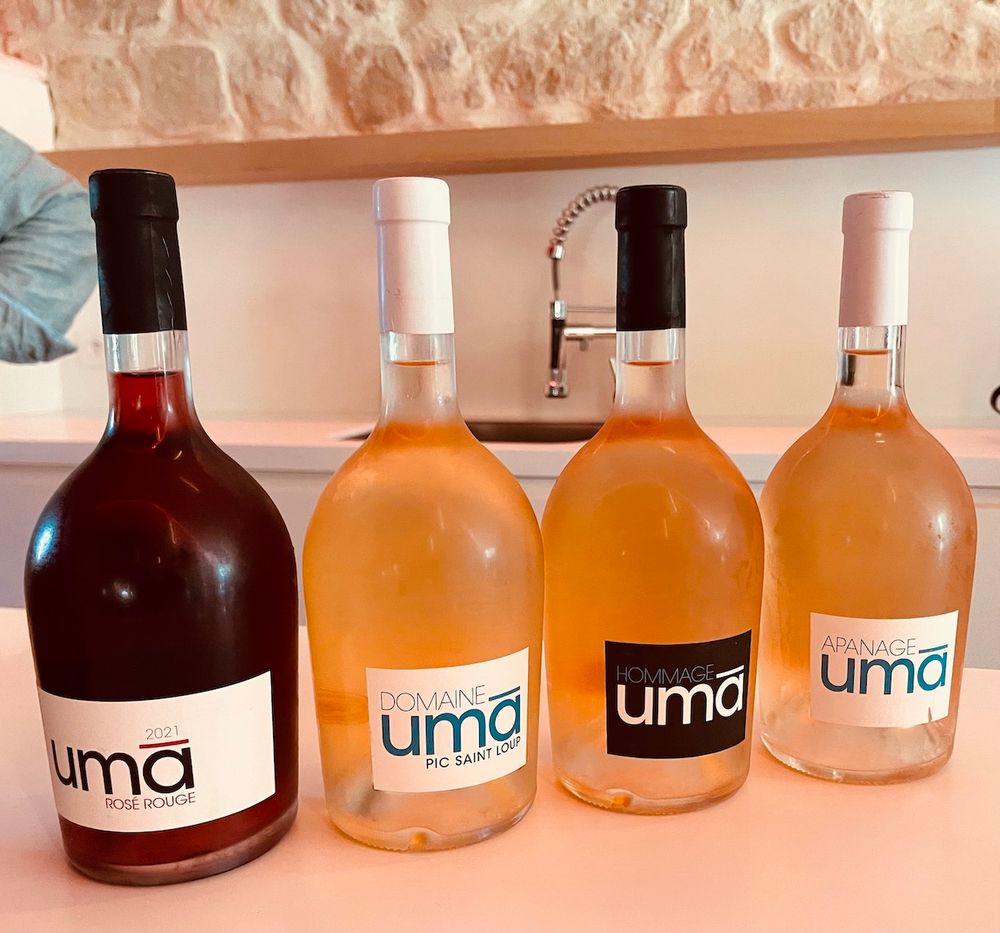
My absolute favourite wine was the dark Uma Rosé Rouge 2021, which retails at around €17. There is something so lavish, forbidden and sensual about a cherry red rosé, which was magnificent in its moreish simplicity. Uma does not use wood in its reds, though they have inherited a single foudre. The wines show fruit elegance and are tinged with salinity. Turner bills Uma Rosé Rouge as an alternative to red on a hot day “like a rosé but with more aromas, structure and some tannin so it’s better adapted for food, it’s what I want to drink when it’s hot.” There is no residual sugar in any of these wines.
Domaine Uma has yet to reveal its wines to the world and is looking for UK representation.
Domaine Uma, Organic Rosé Rouge 2021, Vin de France 12.5%, 100% Cinsault.
Forty-eight hours of skin contact, zero sulphur, hence the vibrant peony hue. The wine is redolent with wild strawberries, raspberries and cherry blossoms. Fresh, round, sapid and infinitely quaffable, the wine is made moreish by a tender touch of salinity. It’s absolutely perfect for a summer wedding or greasing up hardened wine hacks. J’adore.
Domaine Uma Apenage Rosé 2022, IGP Pays D’Oc 12.5%, 70% Merlot, 30% Syrah. (retails for under €10 in France). Half free run/half press. Classic pale salmon rosé, fresh and beautifully complex and far more textural than your average Provence rosé with which it shares its hue. Layers of fruit and that gorgeous salinity, too. It’s so much more interesting than many a rosé at two or three times the price.
Domaine Uma Homage Rosé 2022, IGP Pays D’Oc 12.5%, 70% Merlot, 30% Syrah.
All free run juice. Ferments a little warmer with a different yeast for more grapefruit and citrus flavours. It is more classically elegant and austere. Still with a savoury edge and a tip of salinity. Classy.
Domaine Uma Pic Saint Loup Rosé 2022, IGP Pays D’Oc 12.5%, 70% Grenache, 30% Syrah, (top end line, about €20 in France) More gastronomic. Steeped in elegance, poise and grace, this wine is everything I am not.
Domaine Uma Arpanage Pic Saint Loup Red, 2021 13.5%, 70% Syrah, 30% Grenache. Aged in cement. Fine, clean and fruity with plum, pepper, spice, violet and black olive – shows an elegant mineral-laced freshness and a delicate softness courtesy of the Grenache.
Domaine Uma Homage Pic Saint Loup Red, 2021 13.5%, 80% Grenache, 20% Syrah
Floral and beautiful, there is a peppery freshness to this wine, the nose is very pretty – aged in concrete for texture and fruit, organic and naturally fermented, a fantastic example of terroir expression.
Domaine Uma Apenage White, St Guilhem le désert 2022 13.5%, 70% Roussanne, 15% Semillon, 15% Rolle (Vermentino). Beautifully dry and mineral-rich, not too boozy, vinified and aged in cement tank – elegantly rounded – Turner says its rounder than she would like. These wines graduate in finesse rather than concentration.
Domaine Uma Homage White, Languedoc 2022 13.5%, 55% Rolle, 45% Rousanne. (sells for €24.50 in France). A gorgeously complex, textural, dreamboat; silkily laced with fragrant savoury herbs, candied lemon, beeswax and orange blossom. Made from three Rolle blocks all vinified differently, the first was a cool ferment, the second hot and the third was wild yeast and “took ages.” Sublimely fresh and salty, a wine to really savour. Magnificent.
The wines of Les Vignobles Foncalieu
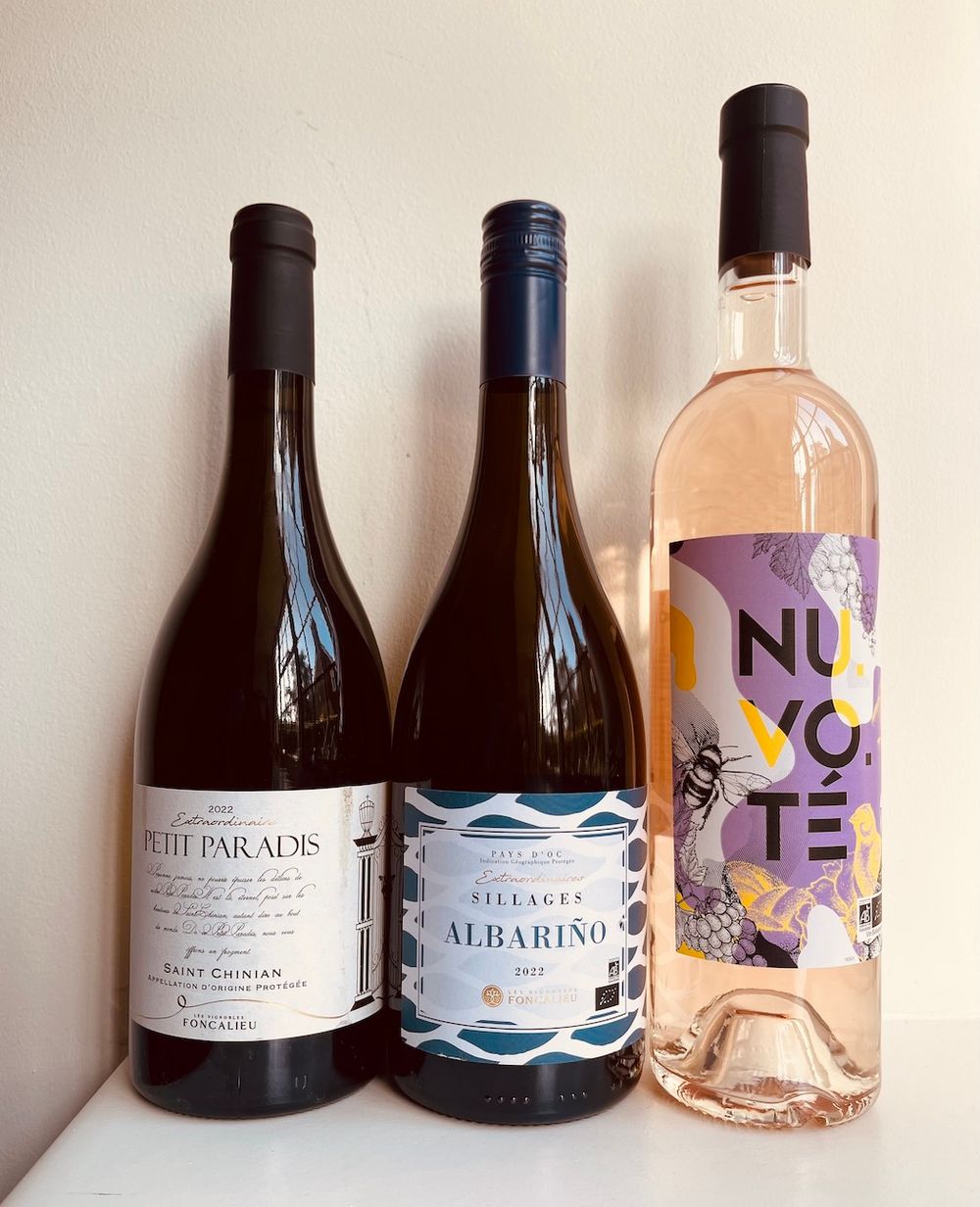
All of these wines offer astonishing value for wines of this calibre and with sustainability at their heart. The first wine I have included is made from PIWIs. It demonstrates Foncalieu’s commitment to organic farming. My personal favourites are the two sapid, salty lusciously elegant whites, both offer insane value and zero compromise.
Nuvote Organic Rosé 2022, Vin de France, 12%. An exciting wine made from French PIWI varieties, Vidoc and Artaban – PIWIS are crosses between European vines and fungus/frost-resistant American species, they allow for a huge reduction in pesticide use (Nuvote is organic). Vidoc and Artaban are ideal for warmer climates, retaining acidity even as temperatures rise. On the nose there is peach sherbet, candied lemon and sweet cherry blossom. The palate is super dry yet supple and silky – weightier and rounder than expected with a bone-dry, sherbet finish. Seeking UK representation.
Les Extraordinaires, Sillages Organic Albariño, IGP Pays D’Oc 2022, 12.5%. 100% Albariño, Circa £11.Grown in a cool Mediterranean setting to preserve freshness. Layered, gorgeous – insane value. White peach, apple, lime, oily almond, apricot, tart candied lemon and jasmine blossom. Fresh, sapid, moreish – round yet zippy too. The finish is long and pithy with salted melon and grapefruit. I could quaff this day and night.
Foncalieu Petit Paradis Blanc, St Chinian 2022, 12.5%. 50% Grenache Blanc, 30% Marsanne, 20% Rolle, Circa £10.99. Each variety is vinified separately, French oak for the Rolle and partial oak for the Marsanne, the rest in stainless steel. Fragrant honeysuckle, sweet jasmine and zingy lime sherbet – superbly textural, pétillant, round yet fresh and salty with minerals and a white pepper-laced finish. To find a white St Chinian this for this money is a massive result.
Château Haut Gléon, AOP Corbières, 2021, 12.5%. Roussanne, Rolle, Grenache Blanc. £19.95. Superbly textural, fresh, salty, pithy and aromatic, there is generosity from the Grenache and floral notes of honeysuckle and lemon verbena with candied lemon, pear, minerals, oily almond and white pepper. So layered and interesting, sapid and moreish. Delicious.
Foncalieu Via Nostrum, Corbières AOP, 2020, 13%. Circa 80% Syrah, 20% Grenache. £13. 20% is vinified for a year in second-use French oak barrels. What a lot for so little – super vibrant nose redolent with dark fruits, sweet morello cherry, black olive, garrigue and wet woodsmoke. Tannins are pronounced and the finish brings on the sensation of mouth-moistened, just-rolled cigars and golden tobacco. Structured, spicy, with a moreish sweetness tempered by tannins, savoury salty olives and toasted vanilla.
Foncalieu L’Apogée, Corbières AOP, 2019, 13%. 85% Syrah, 15% Grenache. Circa £16. Deep and dense with ripe fruit, liquorice, bitter chocolate, black olives. It’s tarry and super ripe but tempered by delicious, moreish, salty tapenade notes and velvety tobacco-tinged tannins that give a fresh sensation. A touch of wet woodsmoke and fragrant garrigue bring a delicate menthol note.
Foncalieu La Lumière, AOP Corbières, 2019, 13%. 70% Syrah, 30% Mouvèdre. Circa £25. This premium small batch wine sees 12 months in new oak barrels. Billed as less rustic and more terroir expressive, it is deep, rich, spicy and dark on the nose; wild black fruit finds equilibrium in olive tapenade, liquorice, moist, just-rolled tobacco, black chocolate and wet woodsmoke. Tannins are dry and present. Opens up in the glass to display elegance, freshness, balance and length.
